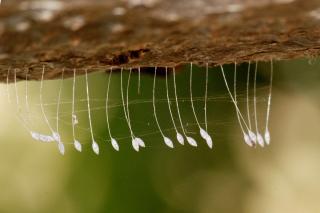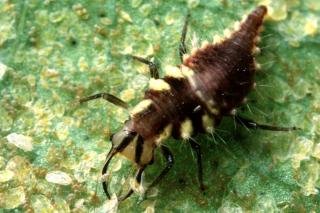

Green lacewing also goes by more dramatic and telling names: golden-eyed fairy, aphid lion, aphid wolf… and each name reveals how much of a beneficial insect this is to a gardener trying to control pests. Larvae from this insect family seem to have a single goal in life: to devour aphids.
Adults, for their part, take on another task in the orchard grove and the vegetable patch: they are excellent pollinators. Read also:
The common name “green lacewing” actually relates to three distinct species – but they look so much alike that they’re hard to tell apart. The main difference among them is the habitat where they live:
Adults are between 23 and 30 mm long (about an inch). Their body is long and narrow, green in color. There is a thin yellow line along the back on their thorax and abdomen. In Winter, during hibernation, green lacewing takes on a yellowish to brown-red hue. Larva vary in size according to their developmental stage. In the first stage, they’re only 2mm long, and reach 8mm (1/4th inch) in the third stage. Their body shape is also narrow, yellow-brown in color and hairs stick out on the sides. Typical of this kind of larva is the pair of huge mandibles that are larger even than their head.
 Adults are mostly active at night, from Spring to Fall. Like the ladybug, they change color as Winter rolls in. Taking the cue from shortening days and dropping temperatures, green lacewing gather together to find shelter and hibernate during several months. In the next Spring, they turn green again and quickly start reproducing. Depending on how much food is available and how diverse it is, a female green lacewing can lay over 20 eggs a day. After 4 to 10 days, the eggs hatch and the newborn green lacewing larva reaches adulthood within 2 to 3 weeks.
Adults are mostly active at night, from Spring to Fall. Like the ladybug, they change color as Winter rolls in. Taking the cue from shortening days and dropping temperatures, green lacewing gather together to find shelter and hibernate during several months. In the next Spring, they turn green again and quickly start reproducing. Depending on how much food is available and how diverse it is, a female green lacewing can lay over 20 eggs a day. After 4 to 10 days, the eggs hatch and the newborn green lacewing larva reaches adulthood within 2 to 3 weeks.
 There are two advantages to welcoming green lacewing to your garden:
There are two advantages to welcoming green lacewing to your garden:
Since adults essentially rely on nectar and pollen for food, it’s important for your garden to count a great many flowers, with blooming periods that overlap and cover the whole year. You’ve got several options here:
Make hibernating easier, too: build an insect hotel and complement it with shelters that the insect might find appealing: a pile of leaves, a few tiles or clay shingle laid down across a couple sticks, etc. Food-craving larvae, pollinating adults: it makes perfect sense for green lacewing and gardeners to get along well! They’re the best of allies that will make your garden flower and bear fruit abundantly.
Read also:
If you order lacewing to control pests in your garden, it’s best to order them at the egg stage. Larvae will stay put and stay in your garden instead of flying away as adults would.